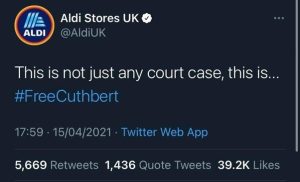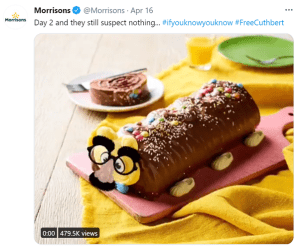ARTICLE
BATTLE OF THE CATERPILLARS? IT’S BATTLE OF THE SOCIAL MEDIA TEAMS
It’s been a long time coming but Marks & Spencer is now the latest brand to challenge Aldi’s copycat tendencies. However, this isn’t just any court case, this is #FreeCuthbert.
Last week, M&S lodged an intellectual property claim with the High Court, stating the budget supermarket’s Cuthbert The Caterpillar cake bears an uncanny resemblance to its iconic Colin.
M&S claims that their similarity leads consumers to believe they’re of the same standard and “rides on the coat-tails” of its reputation. In an ideal world, M&S wants Aldi to remove the product from sale and agree not to sell anything similar in the future.
But, despite the severity of the situation, Aldi appears to have taken it all in its stride, using Twitter to have a dig at the famous M&S adverts:

And they didn’t stop there. Aldi’s social media team were not holding back, posting about ‘caterpillar gate’ 12 times in 24 hours.

#FreeCuthbert attracted quite the crowd, encouraging other companies to jump on the bandwagon and show their support for the budget supermarket. M&S fans were also quick to hit back with their own #SaveColin campaign, expanding the reach of both brands.

This isn’t the first time Aldi has used social media to make the best of a bad situation. Last year, BrewDog highlighted similarities between Aldi’s Anti-Establishment Beer and the brand’s Punk IPA on Twitter.
BrewDog’s boss threatened to launch a new beer called Yaldi and claimed Tesco was interested in stocking it. After a brief Twitter spat, the two firms kissed and made up, before announcing the birth of ALD IPA.
Aldi proved, yet again, the power of social media as a tool for raising brand awareness, sparking conversation, and ultimately driving sales.
Why not take a leaf out of Aldi’s book? Here are some top tips on using social media for business success:
1. Understand the algorithm
Twitter’s aim is to provide users with great content that they’ll want to engage with.
The algorithm rewards businesses that share content which their audience engages with, while penalising them for sharing less engaging content.
Essentially, engagement is king. Start by crafting quality posts, then let the followers to do the legwork.
2. Make genuine connections
Human connection is the foundation for every great brand. When people see companies communicating directly with followers, it becomes clear that they care about their community.
What’s more, when you tweet people directly, you’re far more likely to receive a response, a like, or a retweet, which helps boost that all-important engagement.
3. Tweet often
According to research from CoSchedule, the optimum number of tweets, including retweets, is 15 per day.
Regular posting positions brands as being up-to-date and ensures they remain front of mind for customers.
4. Use social media for customer service
Twitter’s personal, conversational nature lends itself to handling any customer queries or issues.
The openness and transparency of interactions also helps create a sense of community, and ensures customers feel supported and listened to.
5. Get it trending
A catchy hashtag can work wonders, lifting content to new levels – it can create strong alliances and dramatic divides.
#FreeCuthbert certainly climbed to dizzy heights in the past week, with the original post generating over 10K retweets and 73K likes, proving just how important hashtags are at sparking a conversation online.
For support creating social posts that pack a punch, get in touch here.
Looking for more?
Sign up to our “Pearls of Wisdom” newsletter here.










